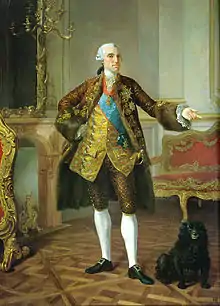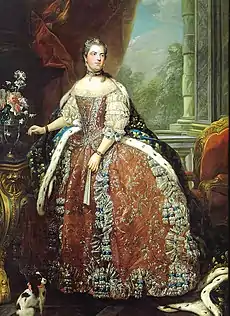Ferdinand, Duke of Parma
Ferdinand (Ferdinando Maria Filippo Lodovico Sebastiano Francesco Giacomo; 20 January 1751 – 9 October 1802) was the Duke of Parma, Piacenza and Guastalla from his father's death on 18 July 1765 until he ceded the duchy to France by the Treaty of Aranjuez on 20 March 1801. He was a member of the Spanish House of Bourbon.
| Ferdinand | |||||
|---|---|---|---|---|---|
 | |||||
| Duke of Parma, Piacenza and Guastalla | |||||
| Reign | 18 July 1765 – 9 October 1802 | ||||
| Predecessor | Philip | ||||
| Successors |
| ||||
| Born | 20 January 1751 Parma | ||||
| Died | 9 October 1802 (aged 51) Fontevivo | ||||
| Spouse | Archduchess Maria Amalia of Austria | ||||
| Issue more... | Carolina, Princess Maximilian of Saxony Louis I of Etruria Princess Maria Antonia Princess Maria Carlotta | ||||
| |||||
| House | Bourbon-Parma | ||||
| Father | Philip, Duke of Parma | ||||
| Mother | Louise Élisabeth of France | ||||
| Religion | Roman Catholicism | ||||
Early life
Born at the Ducal Palace of Colorno as the second child and only son of Philip, Duke of Parma, and Princess Louise Élisabeth of France, he was considered to be the favorite grandson of his maternal grandfather King Louis XV of France. As a grandson in the male line of King Philip V of Spain, he was created an infante of Spain after upon his father's death. As a grandson of King Louis, Ferdinand was also a direct descendant of England's William the Conqueror. As the heir to one of the largest collection of sovereign duchies, Ferdinand was an attractive candidate for many royal ladies of Europe. Probable candidates included the heiress Princess Maria Beatrice Ricciarda of Modena, daughter of Ercole III of Modena and (like Ferdinand) an in law of Marie Antoinette. His possible marriage to Princess Maria Beatrice was, however, very unlikely since the latter had been engaged to Archduke Leopold of Austria (later Emperor Leopold II) at a very young age and later on to Leopold's younger brother, Archduke Ferdinand, upon the death of an older brother, Archduke Charles. It is likely that a union between Parma and Modena was only promoted in vain by Parma's Minister, Du Tillot, since the engagement of Modena's heiress to an Austrian Archduke was already agreed very early on. Another candidate was Louise Marie Thérèse Bathilde d'Orléans who offered a very large dowry; she was the only surviving daughter of Louis Philippe I, Duke of Orléans, and the sister of Philippe Égalité.
The decision of who his future spouse would be, was sealed by his mother's close correspondence with the powerful Empress Maria Theresa of Austria, who had promised Ferdinand's parents the throne of the Netherlands, which had been returned to Austrian rule under the Treaty of Aix-la-Chapelle. This never occurred and, as a result, an alliance with the Austrian Empire was used to cement the two nations. This alliance was also encouraged by the Parmese Prime Minister Guillaume du Tillot, who had worked at Versailles and had been exiled by Louis XV of France due to his liberal ideas, which were not looked upon with much enthusiasm by those at Versailles.
Reign
Guillaume du Tillot was again used during Ferdinand's reign when he lost his father in 1765 aged 14. Negotiations and ideas were passed from Vienna to Parma and in 1769, Ferdinand was to marry Archduchess Maria Amalia of Austria; the eighth child of the Empress and older sister of the Queen of Naples and Sicily and the future Queen of France. Maria Amalia had a marriage by proxy in Vienna on 27 June and left her home on 1 July. The future duchess would meet her husband at Mantua on 16 July. His wife was with her brother Joseph II, Holy Roman Emperor and Ferdinand with members of the Sforza family. On 19 July there was a formal ceremony for all at the Ducal Palace of Colorno where Ferdinand had been born. During many festivities, the couple made their official entrance to Parma on 24 July. They had nine children in just under twenty years.
Expelling the Jesuits, abolishing the jurisdiction of the Inquisition within his domains, and suppressing many redundant monasteries, Ferdinand has sometimes been classed among the more minor exponents of Enlightened absolutism.
Ferdinand ceded the Duchy of Parma to France in the Treaty of Aranjuez (1801). The Treaty of Aranjuez was signed on 21 March 1801 between France and Spain. The overall accord confirmed the terms presented in the Treaty of San Ildefonso. Moreover, Ferdinand agreed to surrender the Duchy of Parma (with Piacenza and Guastalla) to France. Ferdinand's son Louis received the Grand Duchy of Tuscany, which became the Kingdom of Etruria. Ferdinand III, the Habsburg Grand Duke of Tuscany, was compensated with the secularized territories of the Archbishop of Salzburg.
He died in Parma at age 51, suspected to be poisoned although French authorities cited another reason for his death, and was buried in the church of Fontevivo Abbey. On his deathbed, however, he named a regency council with his wife Maria Amalia as its head, clearly still opposing the terms of the Treaty of Aranjuez regarding his duchy. The regency lasted only for days and the Duchy of Parma was annexed to France.
Issue
Ferdinand and Maria Amalia had nine children, but only four survived childhood:
- Carolina (22 November 1770 – 1 March 1804). Married Prince Maximilian of Saxony and was the mother of King Frederick Augustus II and King Johann I of Saxony.
- Louis (5 July 1773 – 27 May 1803). The first of only two kings of Etruria. Married his first cousin, Maria Louisa of Spain.
- Maria Antonia (28 November 1774 – 20 February 1841), joined the religious order in 1802 and became an Ursuline abbess.
- Maria Carlotta (7 September 1777 – 5 April 1813), joined the Dominican order in 1797 and became a prioress
- Philip Maria (22 March 1783 – 2 July 1786).
- Antonietta Luisa (21 October 1784), died shortly after birth.
- Maria Luisa (17 April 1787 – 22 November 1789) died in infancy.
- Maria Enrichetta (10 February 1788 – 24 January 1799)
- Stillborn son and daughter (21 May 1789)
Ancestry
| Ancestors of Ferdinand, Duke of Parma[1] | ||||||||||||||||||||||||||||||||||||||||||||||||||||||||||||||||||||||||||||||||||||||||||||||||||||||||||||||||||||||||||||||||||||||||||||||||||||||||||||||||||||||||||||||||||||||||||||||||||||||||||||||||||||||||||||||||||||||||||||||||||||||||||||||||||||||||||||||||||||||||||||||||||||||||||||||||||||||||||||||||||||||||||||||||||||||||||||||||||||||||||||||||||||||||||||||||||||||||||||||||||||||||||||||||||||||||||||||||||||||||||||||||||||||||||||||||||||||||||||||||||||||||||||||||||||||||||||||||||||||||||||||||||||||||||||||||||||||||||||||||||||||||||||||||||||||||||||||||
|---|---|---|---|---|---|---|---|---|---|---|---|---|---|---|---|---|---|---|---|---|---|---|---|---|---|---|---|---|---|---|---|---|---|---|---|---|---|---|---|---|---|---|---|---|---|---|---|---|---|---|---|---|---|---|---|---|---|---|---|---|---|---|---|---|---|---|---|---|---|---|---|---|---|---|---|---|---|---|---|---|---|---|---|---|---|---|---|---|---|---|---|---|---|---|---|---|---|---|---|---|---|---|---|---|---|---|---|---|---|---|---|---|---|---|---|---|---|---|---|---|---|---|---|---|---|---|---|---|---|---|---|---|---|---|---|---|---|---|---|---|---|---|---|---|---|---|---|---|---|---|---|---|---|---|---|---|---|---|---|---|---|---|---|---|---|---|---|---|---|---|---|---|---|---|---|---|---|---|---|---|---|---|---|---|---|---|---|---|---|---|---|---|---|---|---|---|---|---|---|---|---|---|---|---|---|---|---|---|---|---|---|---|---|---|---|---|---|---|---|---|---|---|---|---|---|---|---|---|---|---|---|---|---|---|---|---|---|---|---|---|---|---|---|---|---|---|---|---|---|---|---|---|---|---|---|---|---|---|---|---|---|---|---|---|---|---|---|---|---|---|---|---|---|---|---|---|---|---|---|---|---|---|---|---|---|---|---|---|---|---|---|---|---|---|---|---|---|---|---|---|---|---|---|---|---|---|---|---|---|---|---|---|---|---|---|---|---|---|---|---|---|---|---|---|---|---|---|---|---|---|---|---|---|---|---|---|---|---|---|---|---|---|---|---|---|---|---|---|---|---|---|---|---|---|---|---|---|---|---|---|---|---|---|---|---|---|---|---|---|---|---|---|---|---|---|---|---|---|---|---|---|---|---|---|---|---|---|---|---|---|---|---|---|---|---|---|---|---|---|---|---|---|---|---|---|---|---|---|---|---|---|---|---|---|---|---|---|---|---|---|---|---|---|---|---|---|---|---|---|---|---|---|---|---|---|---|---|---|---|---|---|---|---|---|---|---|---|---|---|---|---|---|---|---|---|---|---|---|---|---|---|---|---|---|---|---|---|---|---|---|---|---|---|---|---|---|---|---|---|---|---|---|---|---|---|---|---|---|---|---|---|---|---|---|---|---|---|---|---|---|---|---|---|---|---|---|---|---|---|---|---|---|---|---|---|---|---|---|---|---|---|---|---|---|---|---|---|---|---|---|---|---|---|---|---|---|---|---|---|---|---|---|---|---|---|---|---|---|---|---|---|---|---|---|---|---|---|---|---|---|---|---|---|---|---|---|---|---|---|---|---|---|---|---|---|---|---|---|---|---|---|---|---|---|---|---|---|---|---|---|---|---|
| ||||||||||||||||||||||||||||||||||||||||||||||||||||||||||||||||||||||||||||||||||||||||||||||||||||||||||||||||||||||||||||||||||||||||||||||||||||||||||||||||||||||||||||||||||||||||||||||||||||||||||||||||||||||||||||||||||||||||||||||||||||||||||||||||||||||||||||||||||||||||||||||||||||||||||||||||||||||||||||||||||||||||||||||||||||||||||||||||||||||||||||||||||||||||||||||||||||||||||||||||||||||||||||||||||||||||||||||||||||||||||||||||||||||||||||||||||||||||||||||||||||||||||||||||||||||||||||||||||||||||||||||||||||||||||||||||||||||||||||||||||||||||||||||||||||||||||||||||

 Princess Louise Élisabeth of France (his mother) by Louis-Michel van Loo
Princess Louise Élisabeth of France (his mother) by Louis-Michel van Loo.jpg.webp)
 Ferdinand as a young man
Ferdinand as a young man
 Duke Ferdinand of Parma with Maria Amalia
Duke Ferdinand of Parma with Maria Amalia
References
- Genealogie ascendante jusqu'au quatrieme degre inclusivement de tous les Rois et Princes de maisons souveraines de l'Europe actuellement vivans [Genealogy up to the fourth degree inclusive of all the Kings and Princes of sovereign houses of Europe currently living] (in French). Bourdeaux: Frederic Guillaume Birnstiel. 1768. p. 96.
Ferdinand, Duke of Parma Cadet branch of the House of Capet Born: 20 January 1751 Died: 9 October 1802 | ||
| Regnal titles | ||
|---|---|---|
| Preceded by Philip |
Duke of Parma, Piacenza and Guastalla 1765–1802 |
Vacant Annexed by French Republic Title next held by Marie Louiseas sovereign duchess |
.svg.png.webp)
